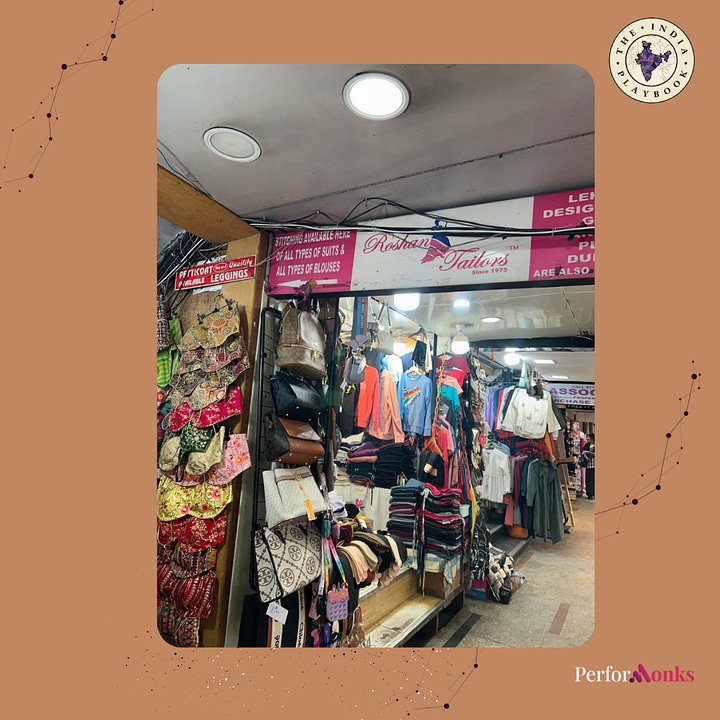Keep improving what you are uniquely good at
Category of one is not about scale. It's about building moats around what you are uniquely good at.
The India Playbook decodes Category of One business strategies. Find the archives here. Join 3,844 subscribers.
The more I polish my India Playbook tinted spectacles, the more I spot Category of One businesses around me. Today’s newsletter shares three local privately owned businesses that unbeknownst to them, have become category of one.
That’s the thing. Most category of one businesses are not trying to be anything.
They find one thing they are uniquely good at and keep improving at it day in and day out. Decade in-decade out.
That’s it. That’s the twenty-word secret formula.
This is what it looks like in action.
Prince Chaat Corner: world famous in G.K.1
Prince Chaat Corner started in 1965 as a pan1 shop.2 It then bought the shop next door and expanded to chaat.
Its Palak ki Chaat (Spinach fritters chaat) is its best seller. It has kept up with the times and now sells gol gappas3 with mineral water.
Its website says they have served 17 million customers and 21.8 million plates of chaat. Assume each plate costs Rs.140/- that’s Rs.305 crores ($36.7 million) topline. (It’s unclear if this counter is for 59 years or just last year).
To put this in context, McDonald’s 2013 revenue was Rs.2,200 crores ($265 million).
Not bad for a family-owned business.
But I digress. It’s not about scale. A category of one business can be $1 million, or it can be $100 billion. Regardless of size, a category of one business builds such a formidable moat that no other business can even consider taking it on.
Location. Location. Location. That’s the moat here. Prince Chaat Corner was in Greater Kailash 1 (G.K.1) before G.K.1 was the shopping destination where Delhi’s rich and famous devour chaat while their drivers carry lakhs worth of their shopping to the car.
Let’s see the second business.
In G.K.1, turn left from Prince Chaat Corner, walk a few meters and down a steep staircase. You find Roshan Tailors in a basement.
Roshan Tailors: consumer obsession in a basement
You will see row after row of designer blouses. The narrow corridor is jammed with women hunting for that perfect style and color. They know the tailor will stitch it if they can’t find it.
The moat here is consumer obsession and agility.


I spoke to the owner, and he credited all their success to their consumers. He didn’t think he was doing anything special. All they do, he said, is take requests from women who bring in pictures and samples of blouse designs. He stitches what they want. And within a week, he recreates the same design in many different fabrics.


This gives them an edge in the only thing that’s super important in their category (fashion) - selection and latest styles. And they become a category of one business.
There’s another shop that sells blouses in the same market. That shop has a better location, i.e., it’s not in the basement. And let me tell you, this shop was not swarming with consumers.
Roshan Tailor’s consumer obsession drew women to it like bees to honey.
Neelam Foodland: satiating tastebuds in ten countries
This is a category of one business because of its entrepreneurial spirit.
In my corporate job, the sales team ensured I visited Neelam Foodland whenever I went for market visits in Mumbai. It’s every food salesperson’s gold standard.
Neelam started in 1980 and has kept pace with the times. They have an online ordering system in India and ten countries. They have gone beyond traditional flavors and have innovated 10-20 new flavors of khakhra and bakarwadi.4
These are just three examples. There are millions of small businesses all over the world that have become legends and attract thousands of buyers daily - that BBQ grill master in Texas, that pizza with hot honey in NYC, that dosa corner in Bangalore, or that Galouti kebab in a dingy alley in Lucknow.
What do they do different? They don’t walk up and down the same calf paths.
The moral of the story
The most common calf path? Our obsession with global domination and scale has made business an Olympic-level sport. Unicorn valuations somersault and funding winters tumble down with a speed that makes Simone Biles blush. Investors sprint to be the first to back promising startups, leaving Usain Bolt squinting through dust while tying his shoelaces.
But there is a different kind of sport. A one-person race. A multi-decade-long marathon of one.
These businesses don’t hire consultants from McKinsey. Instead, they focus on the one thing they know they do well. And they keep doing it again and again. Over time, they become so famous, so good at what they do, and so valuable that they don’t need to go to consumers. Consumers come to them.
Be the only. Play the ‘category of one’ game.
Thanks for reading!
For my readers in the west, Paan is eaten after meals. It is a mouth freshener and has digestive properties. It’s made of betel leaf with fillings of various mouth fresheners. Read about it here.
Chaat is Indian street food. Its main element is fried - hash browns like potatoes or fried chips, which are then smothered in a lot of sweet-spicy-tangy sauces, chickpeas, and curd. Watch this short video to see what it is.
Another kind of chaat. Also called Paanipuri. Fried balls of dough that are hollowed out and filled with sweet-spicy liquid and eaten in one go.
My readers in the West - just come to India to try all these snacks. (Nikki and Holly, I’m talking to you). Until then, here’s a description of flavor bombs that should be experienced instead. What is Kakhra. What is bakarwadi.
p.s.Watch this IG reel on Neelam Foodland here.






